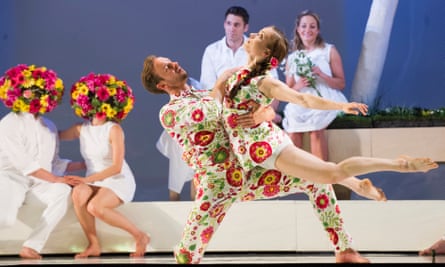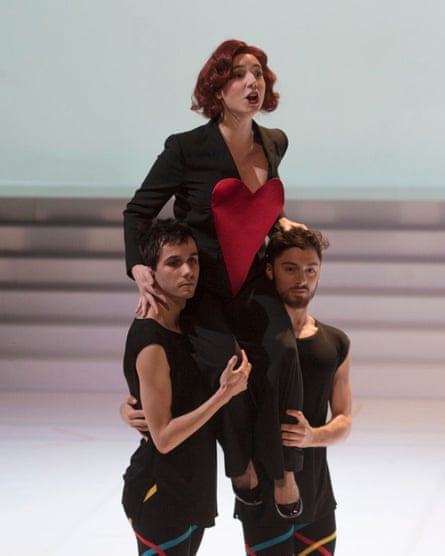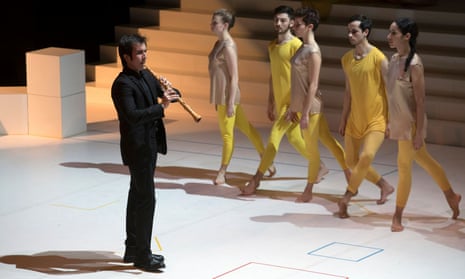This week the Royal College of Music is staging a UK premiere of an opera so successful that it had 80 performances in its first year in France and four revivals over the following three decades. And yet it’s taken 278 years for it to come to the UK.
It is startling to realise that there has not yet been a staged performance of Jean-Philippe Rameau’s Les Fêtes d’Hébé in Britain. Rameau is a composer every bit as important in our understanding of the era as his contemporaries Bach, Handel, Vivaldi and Scarlatti, and the French composer’s opéra-ballet is full of beautiful and charming music, with dance, song and chorus combining to entertain and delight.

And yet Rameau’s music is rarely performed, despite the great efforts of his champions. Only half of his 30 operas are available in modern editions, and major British opera companies have managed only three productions of his works in recent years (ENO’s Castor and Pollux in 2011, Glyndebourne’s Hippolyte et Aricie in 2013, and Platée at the Royal Opera House in 1999).
What could be so frightening about Les Fêtes d’Hébé that we have thus far avoided a production? Is it the music? The fine recording by William Christie and Les Arts Florissants released in 1998, belies this. It was highly praised – described by Gramophone magazine as revealing “a score of infinite and subtle allure. A ravishing entertainment, from start to finish”. Perhaps part of the problem is that Rameau’s opéra-ballet crosses genres, and modern institutions aren’t set up to incorporate all of these disciplines.
Is it a question of depth, or one of specialisation, or simply of taste?
Depth certainly must be a consideration. If you are looking for the tragic, the heroic, the deeply drawn human characters of Handel’s greatest operas, for example, don’t look here. The prologue and three entrées are linked dramatically by only their titles – poetry, music and dance – Les Talens Lyriques, the work’s subtitle. Like three loosely hung tapestries, unchallenging dramas of a mythological Greece are observed by Hébé, as she takes a time-out from the foothills of Mount Olympus and sits on the banks of the Seine to watch the festivities, joined by her fellow gods as they are moved by the power of the arts.

Photograph: Studio j'adore ce que vous faites
Specialisation? Well, the idea of opéra-ballet was peculiarly a French thing. Less serious in tone than the earlier operatic works of Lully, and incorporating extended dance elements, composers such as Campra and Destouches developed the form that saw singing and dancing on equal standing in the drama. Fish and fowl on the same plate – multiple performers interpreting the same story leading to unnecessary complication and confusion? It’s certainly a complicated thing to mount today – for our performances in Paris and London, singers, musicians, dancers and choreographers from four different institutions and at least 10 different countries across Europe and the Americas are taking part to present the drama.
And taste? Where do we stand on our reactions to the rococo? We marvel in our museums and exhibitions at the works of the great Renaissance and the power of the baroque. Do we linger enough at the prettiness of Boucher, Lemoyne, Tiepolo? Maybe our taste is only for the bittersweet Watteau? Even those energetic composers driven to develop newer, freer styles out of the rigour of the baroque – including CPE Bach and Christoph Willibald Gluck – were not satisfied for long with the shallowness of the galant style, and searched further for a greater depth and sincerity. Do we mistake prettiness for gaudiness? Surely there is something here that should do more than divert us, even if its original intent was as a diversion.
In Rameau’s time, the wizardry of contemporary stage technology would have dazzled audiences, complemented by rich and expensive costumes and complex production. The scenes of Greece and pastoral France would have been sumptuous. Our production takes a different line, with modern yet stylised choreography, a mixture of contemporary and symbolist dress, and a simple set with each act characterised by colour. Perhaps this strips away the total art form envisaged by Rameau, but it does move the focus more on to the musical score.
Rameau’s music, however, and the art of his time, is not as frothy as the surface might suggest. The spirit of the French enlightenment was, with its solid foundation in empirical science and rationalist philosophy, moving opinions towards frankly treasonable views on individual liberty and absolute monarchy. When we allow ourselves to look beneath the surface of Rameau’s art, we see him caught in the same current as Voltaire (librettist for a number of his operas), Diderot and d’Alembert, sweeping towards the cataclysm of the French Revolution.

So why should a conservatoire be taking on this project? Because we must continually challenge that which might be considered “conservative” in our etymology. Equally as important as the great works of the canon that a conservatoire must approach are the outliers – those pieces that broaden the vista, that challenge the status quo. So often we find that the eyes of the new generation, undimmed by the familiarity of repetition, see different colours, make different connections, discover new paths. Our musical ambassadors of the future have to develop their own rules and their own understandings. We can teach them how to fly, but they must determine their own direction.
For the student, almost everything is for the first time; here is one of those rare occurrences when this is a first for us all, and with no preconceptions, we need to let the opéra-ballet speak on its own terms. Let the music and the song and the dance and the drama intertwine and intermingle in its own time and space. No thought of its beginning or end – just as the exotically carved tendrils weave their way through the rococo palaces of Paris. We can suspend time and live in the moment – there is no rush for us to be queuing for the boat for Watteau’s Cythera. Instead let us savour the taste of the rare combinations of arts that Rameau has prepared for us, and in doing so allow ourselves to be innocent, to be refreshed, and to be delighted.

Comments (…)
Sign in or create your Guardian account to join the discussion